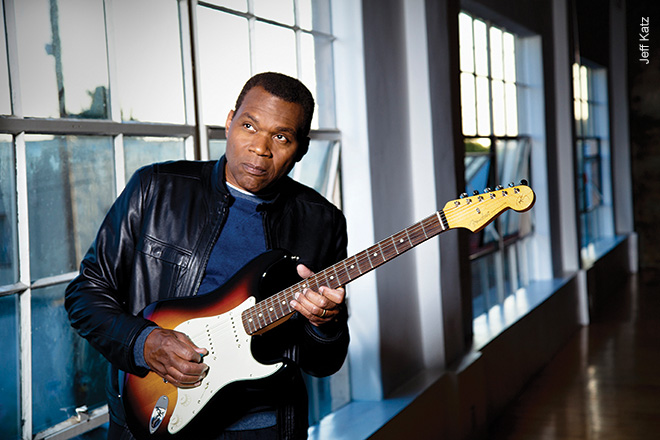ROBERT CRAY
With a compelling mix of blues and R&B, the acclaimed artist is still one strong persuader
After 40 years, 17 studio albums and five Grammys, Robert Cray could be forgiven if he were a braggart. After all, he’s shared the stage with Eric Clapton, Keith Richards, B.B. King, John Lee Hooker, Chuck Berry, Buddy Guy and many more. He’s an ace guitarist and a soulful singer who graced the cover of Rolling Stone in 1987. Yet asked if he feels like one of the blues heroes that he looked up to as a kid, he’ll humbly demur.
“My wife says that now that I’m 61, I’m of legendary status,” he says. “I laugh when she says that. I still see myself as that young guy who started playing guitar a very long time ago.”
Cray’s latest album, In My Soul, offers a well-tended blend of sinewy blues and classic R&B. Aside from covers made famous by Otis Redding, Lou Rawls and Bobby “Blue” Bland, other entries—notably, “Hip Tight Onions” and “I Guess I’ll Never Know”—emulate the sound of Stax Records, and Booker T. and the MGs in particular.
Cray heaps praise on producer Steve Jordan, a master drummer whose production credits include Keith Richards, Herbie Hancock, Buddy Guy, Boz Scaggs and John Mayer. “Steve was there in the studio with us, not isolated in the control room,” says Cray. “He was conducting us, giving us pointers—that’s his forte. Steve’s personality just brings out the best in us. He takes you out of your comfort zone and takes you to a place you haven’t been before. And he makes it fun.
“He’d say, ‘Fellas, this is how I want you to approach this song,’ and then he’d change the snare or bass drum, adjust the mics and the amps—even switch up the guitars for a particular song. Steve’s always been about the sound—and whatever it takes to get it right.”
Cray himself knows a thing or two about getting it right. When he emerged on the scene in the early 1980s, he was hailed as a blues savior, someone who could introduce the genre’s timeless traditions to a new generation of enthusiasts. Early albums Bad Influence and False Accusations proved moderately successful, but his fifth, Strong Persuader, was a breakthrough, garnering a Grammy and the Top 30 crossover hit “Smoking Gun.”
The guitarist caught the ear of Eric Clapton, who invited Cray to join him on tour. And Keith Richards recruited him for the backing band in the 1987 documentary Chuck Berry: Hail! Hail! Rock ’n’ Roll. A decade earlier, Cray landed a cameo in National Lampoon’s Animal House, playing bass for the party band Otis Day and the Knights.
Although the blues continued to command his attention, Cray and his band—bassist Richard Cousins, keyboardist Dover Weinberg and drummer Les Falconer—diversified their approach by embracing R&B. “Our style was a little more straight-ahead in the early days,” says Cray. “So when Strong Persuader came out, some touted it as a blues record even though there’s no blues on that album. But then we began getting grief from the blues purists. It seems you always get grief from people once you become well-known, no matter who you are. Still, it never crossed our minds that we were straying away with any kind of deliberate intent.”
Cray insists his muse has remained consistent. “When you look at the overall picture—not just the blues but music in general—it’s songs mainly about broken hearts. It’s a person telling a story. So if you know that, and if you have a story in mind, you go with it. Don’t let anyone tell you it’s been written before, because you’re the one telling the story this time. At least that’s the avenue we take.”
–Lee Zimmerman




comment closed